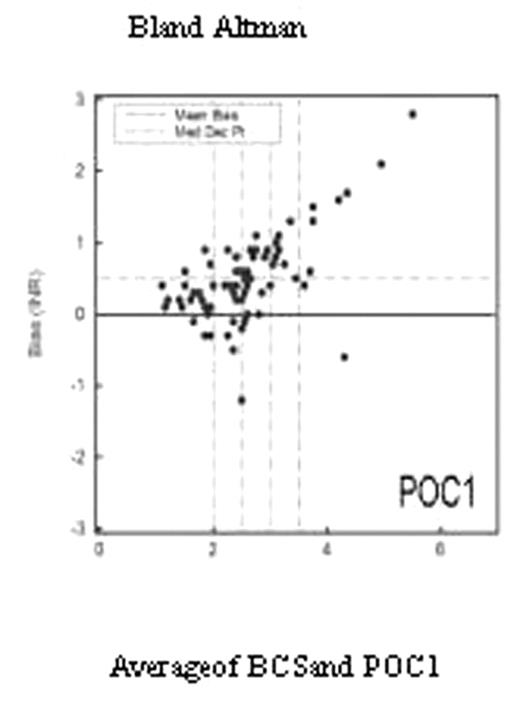Abstract
Oral anticoagulant treatment with vitamin K antagonists has been encumbered by the need for interval monitoring of INRs to adjust dosage. Point of Care (POC) testing of capillary blood has come into widespread use because of the advantages of rapid analysis and dose adjustment. To assess the reliability of this procedure, we compared INR results from 2 POC devices from different manufacturers - POC1 and POC2 - and compared these results to standard assays on venous samples with a BCS automated analyzer.
78 patients on warfarin for at least 3 months were studied. Results of 56 patients with POC2 and 76 patients with POC1 were compared to the BCS. Capillary blood samples were taken within 30 minutes of the venous draw. The therapeutic INR range was considered to be 2.0–3.5.
The bias plots for the 2 POC methods compared to the reference INR are shown in the 2 Figs, below. Within the therapeutic range, 71% and 85% of the results correlated with BCS for POC1 and the POC2, respectively. Both instruments showed the greatest variation from the reference measurement at INR values greater than 2.5 Both POC methods demonstrated clinically relevant overestimates of INR(see table).
Figure
Figure
Agreement % of Reference INR Values to POC INR
| Reference INR* . | POC1-subtherapeutic . | POC1-therapeutic . | POC1-supratherapeutic . | POC2-subtherapeutic . | POC2-therapeutic . |
|---|---|---|---|---|---|
| * INR = 2.0–3.5 | |||||
| BCS-subtherapeutic | 77% | 23% | - | 63% | 37% |
| BCS-therapeutic | 4% | 71% | 25% | 5% | 85% |
| BCS-supratherapeutic | - | - | 100% | - | 33% |
| Reference INR* . | POC1-subtherapeutic . | POC1-therapeutic . | POC1-supratherapeutic . | POC2-subtherapeutic . | POC2-therapeutic . |
|---|---|---|---|---|---|
| * INR = 2.0–3.5 | |||||
| BCS-subtherapeutic | 77% | 23% | - | 63% | 37% |
| BCS-therapeutic | 4% | 71% | 25% | 5% | 85% |
| BCS-supratherapeutic | - | - | 100% | - | 33% |
Conclusion: This study raises a significant question rearding the accuracy of POC methods for INR determinations. Despite ease of use and immediacy of results, the lack of correlation, even under study conditions, and the potentials for under-and overdosing makes relying on these devices problematic.
Author notes
Corresponding author



This feature is available to Subscribers Only
Sign In or Create an Account Close Modal